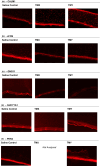Regulation of dermal circadian pathways by a novel topical formulation
- PMID: 39219101
- PMCID: PMC11788004
- DOI: 10.1111/ics.13017
Regulation of dermal circadian pathways by a novel topical formulation
Abstract
Skin health is impacted by a wide range of intrinsic and extrinsic factors (J Dermatol Sci, 2017, 85, 152), including those that impact circadian rhythm, such as sleep disruption (Textbook of Aging Skin, 2016), UV (Biomed Aging Pathol, 2013, 3, 161) and blue light (Int J Cosmet Sci, 2019, 41, 558). Disruption of the skin's endogenous circadian balance, even by a consistently late bedtime, has deleterious effects on multiple measurements of skin health, including hydration, skin barrier protection, microbiome counts and skin regeneration, among others (Clin Cosmet Investig Dermatol, 2022, 15, 1051). Skin repair processes occur at night and help to maintain important aspects of skin health (FEBS Lett, 2021, 595, 2413). Interest is increasing in the development of topical products that help restore proper circadian function. This study demonstrates that a proprietary topical formulation regulates new and established gene and protein biomarkers of circadian entrainment and circadian rhythm, demonstrating the product's potential to maintain appropriate dermal diurnal balance.
La santé de la peau est affectée par un large éventail de facteurs intrinsèques et extrinsèques (J Dermatol Sci, 2017, 85, 152), y compris ceux qui ont un impact sur le rythme circadien, tels que les troubles du sommeil (Textbook of Aging Skin, 2016), les UV (Biomed Aging Pathol, 2013, 3, 161) et la lumière bleue (Int J Cosmet Sci, 2019, 41, 558). La perturbation du rythme circadien endogène de la peau, même par un coucher systématiquement tardif, a des effets délétères sur de multiples mesures de la santé de la peau, notamment l’hydratation, la protection de la barrière cutanée, le nombre de microbiomes et la régénération de la peau, entre autres (Clin Cosmet Investig Dermatol, 2022, 15, 1051). Les processus de réparation de la peau se produisent la nuit et aident à maintenir les aspects importants de la santé de la peau (FEBS Lett, 2021, 595, 2413). L’intérêt est accru dans le développement de produits topiques qui aident à restaurer une fonction circadienne correcte. Cette étude démontre qu’une formulation topique exclusive régule les biomarqueurs génétiques et protéiques nouveaux et établis de l’entraînement circadien et du rythme circadien, ce qui montre le potentiel du produit à maintenir un équilibre diurne cutané approprié.
© 2024 The Author(s). International Journal of Cosmetic Science published by John Wiley & Sons Ltd on behalf of Society of Cosmetic Scientists and Societe Francaise de Cosmetologie.
Figures





Similar articles
-
Cosmeceutical Therapy: Engaging the Repercussions of UVR Photoaging on the Skin's Circadian Rhythm.Int J Mol Sci. 2022 Mar 7;23(5):2884. doi: 10.3390/ijms23052884. Int J Mol Sci. 2022. PMID: 35270025 Free PMC article. Review.
-
Influence of cosmetic formulations on the skin's circadian clock.Int J Cosmet Sci. 2020 Aug;42(4):313-319. doi: 10.1111/ics.12623. Epub 2020 Jun 5. Int J Cosmet Sci. 2020. PMID: 32277494 Free PMC article. Review.
-
Taurine Prevents Impairments in Skin Barrier Function and Dermal Collagen Synthesis Triggered by Sleep Deprivation-Induced Estrogen Circadian Rhythm Disruption.Cells. 2025 May 16;14(10):727. doi: 10.3390/cells14100727. Cells. 2025. PMID: 40422230 Free PMC article.
-
Therapeutic implications of the circadian clock on skin function.J Drugs Dermatol. 2014 Feb;13(2):130-4. J Drugs Dermatol. 2014. PMID: 24509961
-
2016 Arte Poster Competition First Place Winner: Circadian Rhythm and UV-Induced Skin Damage: An In Vivo Study.J Drugs Dermatol. 2016 Sep 1;15(9):1124-30. J Drugs Dermatol. 2016. PMID: 27602977
References
-
- Krutmann J, Bouloc A, Sore G, Bernard BA, Passeron T. The skin aging exposome. J Dermatol Sci. 2017;85:152–161. - PubMed
-
- Guan L, Mehra R, Baron E. Sleep and aging skin. Textbook of Aging Skin. Springer, Berlin, Heidelberg; 2016. p. 2161–2173.
-
- Shah H, Mahajan SR. Photoaging: new insights into its stimulators, complications, biochemical changes, and therapeutic interventions. Biomed Aging Pathol. 2013;3:161–169.
-
- Dong K, Goyarts EC, Pelle E, Trivero J, Pernodet N. Blue light disrupts the circadian rhythm and creates damage in skin cells. Int J Cosmet Sci. 2019;41(6):558–562. - PubMed
MeSH terms
LinkOut - more resources
Full Text Sources

